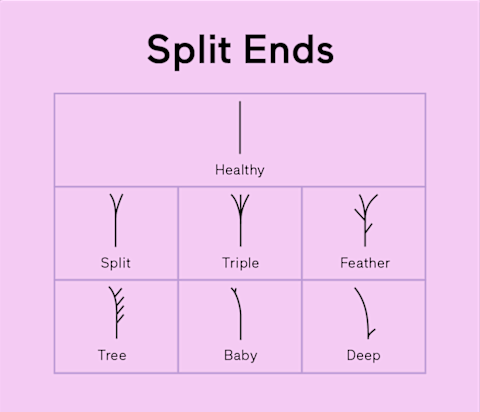Yes, There Are Different Types Of Split Ends: How To Identify & Help The Ones You Have
Did you know there are different types of split ends? It's true: Much like brows, split ends are sisters, not twins. While they each signal damage done to the strand, there are slight nuances to the various types of frays.
But is there a reason we get different types of split ends, or is it pretty much random which one appears on the strand, like some unfortunate surprise gift? And how should we treat the ones we do have? Well, here's what hairstylists have to say.
What are the different types of split ends, and what do they mean?
The different types of split ends range far and wide (others have identified 16 different types of splits, including tapered ends and knots). But for the sake of this article, we'll stick to six of the most common splits: There's your classic "Y" split; a "baby" split at the very tip of the hair; your "triple split" with a fork in the road, so to speak; the "feather" with frays sticking out of both sides; the "tree" with multiple branches in one direction; and the deep split, with frays farther up the hair shaft.

So why might you see these different splits? Well, it typically depends on the amount of damage done to your strands. You don't randomly sprout a "baby" versus a "tree"; rather, a tiny split usually signals the beginning stages of damage. "If [split ends are] not treated, they will continue to split, causing multiple splitting, which can look feathered or tree-like," says hairstylist Gigi Lenora. So if you do notice a few more branches poking out of the strand or deep splits up the hair shaft, it usually indicates more damage on the cuticle.
In terms of the types of damage done (harsh brushing, hot tools, chemical treatments, et al.), it's difficult to tell which habit leads to any one kind of split. In some cases, splits with multiple branches (think "tree" or "feather") stem from heavily processed or chemically treated hair, says hairstylist Maddie Cheatham, founder of Tint Color Bar. But most of the time, damage is damage when it comes to split ends. And more of it—no matter what kind—can worsen the splitting.
How to care for different types of split ends.
No matter what type of split ends you have, there's only one way to truly treat the damage: Snip those hairs clean off. "Once ends are split, this damage is irreversible, and the healthiest option is to trim," Lenora explains.
However, you can also opt for a "dusting" if you're looking to shear those frays without losing any length. Dusting might be an especially great way to get rid of the "feather" or "tree" splits—those branches might stick out more noticeably when you twist a section of hair, making it easier for you to trim them off.
While resorting to scissors is technically the only way to actually "mend" split ends, there are a number of preventive measures to take if you can't see a stylist (so the classic "Y" doesn't turn into a full-on "tree"). That's where your conditioners and masks come into play to seal down the cuticle, as well as stylers to lock in moisture; as hairstylist Jenni Nguyen, owner of Prep & Foxx, tells us about preventing split ends, "If the hair is not properly moisturized and hydrated, split ends and breakage can happen much more frequently." Other than that, there's a host of things you can do to prevent further damage on splitting hairs (all of which are outlined here).
Just don't put off a trim for too long, especially if you do have those "tree" splits. As Cheatham says, "'Tree' splits should be taken care of immediately because it can start to break off at the shaft of the hair if it's not addressed."
The takeaway.
While there are different types of split ends, they each indicate damage on the strand, albeit in varying degrees. They all ultimately require the same treatment (a trim) to start anew, but standard hair care practices can help prevent more damage while you wait for the salon.
Sure, a "baby" might look a tad more unassuming than a "deep" split or "tree," but that doesn't mean you're in the clear: At the end of the day, all splits are irreversible. Better to start with a fresh chop and do your best to fend off future frays.
